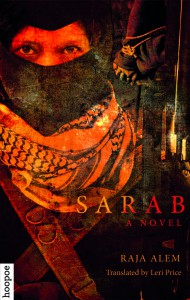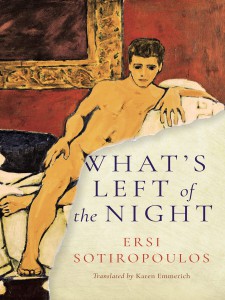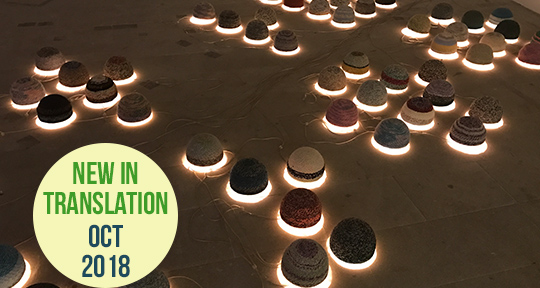Cities can be energizing or inspiring, sites of sensuality or spirituality. Two such cities take center stage in this edition of What’s New in Translation, where our team members introduce you to new and exciting publications.

Sarab by Raja Alem, translated from the Arabic by Leri Price (Hoopoe Books)
Reviewed by Erik Noonan, Assistant Editor
Not only does Sarab, the forthcoming novel by Saudi author Raja Alem, open a new chapter in the fictional treatment of the 1979 siege of the Great Mosque—following Badriah al-Bishr’s Love Stories on al-Asha Street, Yousef al-Mohaimeed’s Where Pigeons Don’t Fly and Alem’s own The Dove’s Necklace (winner of the 2011 International Prize for Arabic Fiction)—it also marks a precarious moment in the development of the global novel. The book first appeared in April in German, and it’s set to be published in English in October by Hoopoe, an imprint of Cairo University Press. The work is intriguing, translated from a text that the novelist does not regard as finished. Since it deals with “a dark chapter in the history of this most holy city” of Mecca—as the Paris resident, Raja, says of her hometown, in a recent interview with Publisher’s Weekly—“I am very sensitive to the words, and up until now I cannot find the right words to capture this story, this wound,” she continues. “I feel I need to rewrite this book in some new Arabic, after taking a distance.” Thanks to translator Leri Price, the Anglophone public who cannot read Arabic can nevertheless now imagine that new Arabic for themselves, across a different, and otherwise uncrossable, distance.
It’s a language of the soul. A gripping account of the battle quickly cedes place to a scene in which Raphael, a Frenchman of the taskforce, a traumatized combat veteran decorated for bravery in atrocities in Mali and Lebanon, engages a Saudi jihadi girl named Sarab in conversation, held at gunpoint at first, “feeble and squalid,” while she disguises herself as a man and calls herself Sayfullah, and then as her equal, when he learns her secret and she does not have the heart to shoot. As the siege lifts, he persuades her to escape with him “to somewhere far away from here, where you can purge your mind of all this war, where you can start a new life, where you can belong to something new.” Post-traumatic stress frays the shroud of reality for “this girl from the desert, delicate and steely,” this “female man” set free in the City of Lights. Her awakening is populated by hallucinations and caressed with sensuality, as the ghost of her brother Sayf breaks in upon her consciousness, and she explores the earthly pleasures of cigarettes, black lipstick, cash, and sexual arousal. Alem details the emotional states of her character in a prose that comes across in Price’s English with an exactitude like that of the late Woolf or early Joyce: “A sense of relief washed over Sarab, as she finally summoned the courage to face the guilt that still flogged her for having clung to life when everyone she knew had gone.”
An atmosphere of courage in the face of destiny pervades the book. Toward the end, when a car strikes Sarab in the crosswalk of a Paris street “bathed in a melancholy, dramatic light,” and she departs this world at age twenty-two, we read that she did not pass into the other world because the bonds of her life had been cut, but because “the suicide belt around her body had been broken.” Alem wrote Sarab intermittently for more than ten years, she tells us, before setting it aside, and resumed the work after meeting a man who had lived through the battle. “The siege of the Grand Mosque was like a wound in the heart of my city, and all along I was going around with this wound but not daring to touch it, because it is so painful,” she notes in the Publisher’s Weekly interview. “It’s a very essential incident, the seed from which sprang all the violence overcoming our world now, the terrorism which caused a deformity to the faith and Mecca, the center of this faith.” In an elegant analogy with the foregoing statement, the author expresses her devotion to the medium of her art: “Arabic is my center,” she claims. It is a place that we, her readers in English, are fortunate to orbit.

What’s Left of the Night by Ersi Sotiropoulos, translated from the French by Karen Emmerich (New Vessel Press)
Reviewed by Barbara Halla, Editor-at-Large for Albania
There is only so much a writer’s correspondence, or their writings in general, can tell us about the creative process that led them to a particular piece of art. Building an entire novel on speculations can be tricky and trying to trace the thought and physical process of how a poem came to be is almost impossible. Yet, as with every good historical novel, questions of accuracy don’t matter quite as much, as seen in Ersi Sotiropoulos’ What’s Left of the Night, translated from the Greek by Karen Emmerich and published by New Vessel Press this October.
At its most basic premise, What’s Left of the Night is about three days in the life of Greece’s most famous modern poet, Constantin Cavafy. During the summer of 1897, Cavafy and his brother John, children of a destitute Greek family living in Alexandria, go on a tour of Europe, ending in with a few weeks in Paris. While the book spans only a short period in Cavafy’s life, the plot is packed with irresistible events and characters unsettling the two brothers along their sojourn. A propitious encounter with Nikos Mardras, secretary to Jean Moréas (another famous, although perhaps now lesser known, Greek poet), leads Cavafy in the heart of bourgeois Paris: Hausmannian apartments where bookshelves are filled with names whose talent now taken for granted: Baudelaire, Anatole France, Marcel Proust, Zola. Cafés where these same authors dine or used to dine, secret clubs, parades at Montmartre, erotic daydreams about a night with a Russian ballet dancer. Sotiropoulos has written a whirlwind novel, full sensations, and events that sweep the reader along as they did the two brothers in the last days of their European tour.
What’s Left of the Night is a modern novel, but it is steeped in the atmosphere of fin-de-sciècle Paris, it revels in its furore and the reader can almost forget this book was written by a contemporary author. It helps that the period is full of tragedies and scandals, from the great fire at the Bazar, to the Dreyfus affair, to the Turkish-Greek war dividing the expatriate Greek community.
The plot itself is enough to entice any reader, but where What’s Left of the Night shines the most is in its reconstruction of Cavafy’s own mind, in his obsession with words and poetry. In how that obsession puts him in conversation not with the people, but the spaces around him. Throughout the book, we often find Cavafy lost: lost in his own memories of the places he had been, the people he loved (or lusted after), of words he had grasped and forgotten in overheard conversations that now torment him with their shadows.
While in Paris, and in the book, Cavafy is working on a poem that, once finished, will become ‘The City’. Sotiropoulous chose this poem, perhaps, because its verses mimic Cavafy’s state of mind. Throughout the story, Cavafy is stuck on these two lines:
The city will follow you. You’ll grow old in the same gray
streets. And through the same neighborhoods you will stray
In fact, it is possible to interpret What’s Left of the Night as a close reading of ‘The City’. Cavafy is the eternal immigrant: born to Greek parents in Alexandria, he spent his childhood between England, Ottoman cities and Alexandria. There is a sense that the two brothers are on this journey to escape their oppressive mother, to escape a pervasive sense of defeat that is rooted in the chaotic past of Alexandria itself. Cavafy had hoped, through this journey, to be inspired by European splendors. Except, that he finds Paris just as rotten, as boring at times, as Alexandria. The breakthrough in this poem comes when Cavafy is lost in one of the lesser known Parisian neighborhoods, far from the architectural landmarks that make the city famous. In the squalor of working-class Paris, thirsty, hungry and feverish he comes to the realization that the issue is not Paris, or Alexandria, the issue is with him, for “once you’ve ruined your life here in this small corner, you’ve ruined it all over the world.”
There is so much to love about What’s Left of the Night: passionate discussions of literature and poetry, extravagant soirées, descriptions of the cultural epoch that gave birth to Proust and the conflicts that would later give rise to World War I. But, most importantly, the book captures the beautiful struggle of trying to reconstruct what it must be like to be tormented by art and language, like Cavafy was, to see it take shape at every corner and every meeting. The brain of this poet seems unable to rest, even his dreams becoming fuel for nightmarish art.
*****
Read more reviews on the Asymptote blog:

